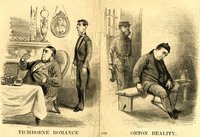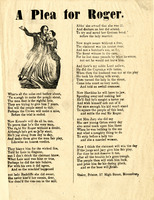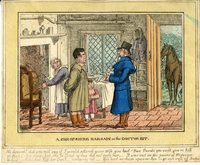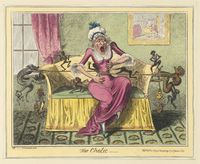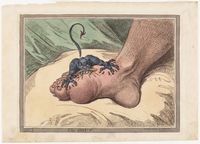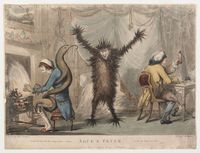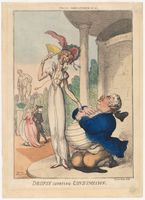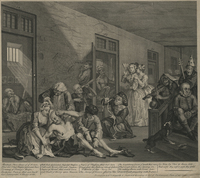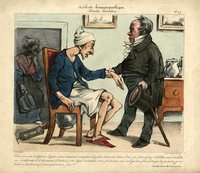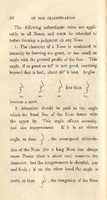Browse Items (29 total)
- Tags: satires
Sort by:
Tichborne Romance and Orton Reality
The Oliver Criminological Collection includes a substantial array of pamphlets, trial accounts, and popular ephemera from the sensational Tichborne Claimant case of the 1870s.
Orton, a butcher in Wagga Wagga, Australia, claimed to be Sir Roger…
A Plea for Roger
The Oliver Criminological Collection includes a substantial array of pamphlets, trial accounts, and popular ephemera from the sensational Tichborne Claimant case of the 1870s, including this broadside satirical poem defending the claims of Arthur…
Satirical engravings
Physicians and the practice of medicine were common subjects for humorous illustrators and caricaturists in the early 19th century. Charles Williams, who worked for the London publisher and print seller, S. W. Fores, produced this set of four…
Indigestion
This print is part of a set that illustrates the discomforts and pain of illness. Note the use of the little demons to explain the cause of pain and illness.
Cholic
This print is part of a set that illustrates the discomforts and pain of illness. Note the use of the little demons to explain the cause of pain and illness.
The Blue Devils!
This print is part of a set that illustrates the discomforts and pain of illness. Note the use of the little demons to explain the cause of pain and illness.
Mixing a Recipe for Corns
Amidst the chaos of her home a grotesque woman is fixated on a conjuring a cure for her corns. Cruikshank is commenting on the pitfalls of self-medication.
The Central Board of Health: Cholera Consultation
In the early nineteenth century cholera epidemics were common. The disease struck its victims rapidly and spread fear amongst the populace. Medical science was ineffective against cholera until John Snow's discovery of its contagion through…
Dr. Sangrado Curing John Bull of Repletion
An excellent example of the use of medical metaphor for political comment, this print depicts one of Gillray's favorite targets, Henry Addington, Prime Minister 1801-1804, bleeding John Bull (Great Britain). Addington, the son of a physician, was…
Comfort to the Corns
Gillray, true to the form of caricature, exaggerates the size of the woman's features and the knife she uses to rid herself of corns.
Metallic Tractors
In 1796 Elisha Perkins, a physician from Connecticut, patented the metallic tractors shown in this print. He claimed the tractors could cure disease through electric force. Gillray's skepticism of this treatment is clear in this satire.
The Gout
Gillray powerfully illustrates the pain and suffering caused by gout, a common ailment of his time.
The Toothache or Torment and Torture
Rowlandson comments on dentistry in this work, suggesting that treatment in the days before anesthesia was as painful as the ailment.
Ague and Fever
Originally published by Rowlandson in 1788, this print shows Ague, the snake, wrapped around the patient, while Fever, the furry monster, stands behind him. On the right is a physician writing a prescription.
A quote by Milton on the bottom of the…
Dropsy Courting Consumption
Dropsy, the stout man, is shown courting consumption, the withered woman. Rowlandson contrasts these 19th century figures to the statue of the classical Hercules.
The Amputation
Rowlandson's derision of the medical profession is illustrated by a group of doctors attempting an amputation.
A Case of Indigestion
In this satire Doyle depicts the Duke of Gloucester with a case of indigestion. The Duke is apparently unaware that of his discomfort is caused by his host's insults at dinner as the doctor states, "Something in the Chancellor's dinner has certainly…
A Cure for the Gout
In this political commentary, Doyle uses gout as a metaphor for the discomfort of the political party that has long been out of favor. When Lord Holland discovers that his party, the Whigs, have been returned to power his gout is cured. Lord Holland…
In Bethlehem Hospital (Bedlam)
Published as the last of a series of eight engravings entitled, A Rake's Progress, this print depicts the story of Tom Rakewell, a wealthy youth who squanders his inheritance because of immorality, carelessness and greed. As he descends into madness,…
The Cow-Pock, or, the Wonderful Effects of the New Inoculation!
As the first professional caricaturist in England, James Gillray is usually remembered for his political and royal satires, but this engraving, poking fun at the work of Edward Jenner, shows the dire consequences of injecting cowpox matter into…
The Battle of the Pills
This cartoon was published in the Boston Evening Times during the height of the controversy over the expulsion of the homeopaths from the Massachusetts Medical Society.
Tags: Exhibit: Grand Delusion, homeopathy, satires
Hay fever
Comic illustrator Augustus Hoppin chronicles the travails of Mr. A. Wiper Weeps as he suffers from an attack of hay fever. In the plate on the right, both allopathy and homeopathy are seen as useless to him. Only a trip in a hot-air balloon for the…
Tags: Exhibit: Grand Delusion, homeopathy, satires
Méthode homœopathique (similia similibus)
This print satirizes the homeopathic doctrine of curing like with like. The caption translates, "You have indigestion, Gastero intero' evacuante! So an hour from now take a little soup, two chops, an omelet, a roast chicken, and twelve dozen oysters.…
Old-School Etiquette
This print originally appeared on the cover of the June 13, 1883, edition of Puck, a humor magazine, and emphasizes
Tags: Exhibit: Grand Delusion, homeopathy, satires
Nasology, or, Hints towards a Classification of Noses
This extended joke at the expense of phrenology passed through several editions in the mid-19th century and was published under the pseudonym of Eden Warwick. George Jabet maintains that the nose, besides being an ornament to the face, or a…
Tags: Exhibit: Talking Heads, phrenology, satires
An Old Maid's Skull Phrenologised
This English satiric print illustrates some of the absurdities associated with phrenology, as the traits and marked skulls of dogs, birds, and horses are treated on a par with humans. The phrenologist "Doctor S." may be intended to represent Johann…
Calves' Heads and Brains, or A Phrenological Lecture
Even in the first years of its popularity during the early nineteenth century, phrenology was a source of amusement to many and became a target for a number of satiric artists of the day, such as George Cruikshank, the "Phiz" illustrator of Charles…

